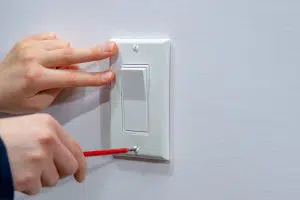How to Replace a Light Switch

Due to the fact that light switches in our homes see so much use, it’s no surprise that they wear out and need replacing eventually. If you’ve noticed that a light switch in your home is loose, fails to control the light fixture, emits a buzzing or crackling noise, or otherwise malfunctions, it may be time to replace your light switch. Luckily, if you’re wondering how to replace a light switch, you should know that this process is actually straightforward.
Today, our Raleigh electricians will be walking you through the process of replacing a light switch. While we always encourage our customers to contact a licensed electrician, replacing a light switch is fairly easy if you understand what you’re doing. After reading this article, you’ll be prepared to replace your own light switch. Let’s get started!
What You Need to Understand About Light Switch Wiring
Before we get to the process of replacing a light switch, it’s crucial that you understand the ins and outs of how light switch wiring works. Light switches are designed to provide an operational break in the hot circuit wire that leads to a light fixture.
By flipping the light switch, you open the lever and close the hot circuit wire, and this is how you turn a light fixture on and off. Due to the fact that there is no neutral wire connection in most light switches, replacing a light switch is fairly easy. Basically, you can replace a light switch by simply disconnecting the two hot wires from the old switch before reconnecting them to the new switch. If you’re working with a single-pole light switch, it should be noted that the hot wires are interchangeable so you won’t even have to worry about which screw terminal to affix them to.
Still, it’s important to know that no electrical job is entirely without the risk of complications. One of the most common problems that homeowners run into when attempting to replace their own light switch involves the grounding of the switch. Back in the day, it was fairly commonplace for light switches to lack any grounding wire connection whatsoever. Instead, circuit ground wires were simply joined together to pass through the circuit box.
When the electrical code was updated to require that wall switches needed a grounding connection, new switches were manufactured to possess a green grounding screw on the mounting strap. If you find yourself replacing an older light switch, you’ll have to connect the new switch to the circuit ground wires regardless of whether or not your switch has a grounding connection.
Important Things to Remember Before Replacing a Light Switch
Before attempting to replace a light switch in your home, you should always turn off the power by switching the circuit breaker off. If your electrical system is older and has fuse panels as opposed to circuit breakers, you can turn the power off by unscrewing the specific fuse responsible for protecting the circuit you’re working on.
Once you have successfully turned off the power, return to the light switch you’ll be working on. Flip the switch to confirm that power is off. If the light comes on or there is any audible indication that power is still flowing through the circuit, go back to the panel and ensure that you’ve turned off power for the correct circuit breaker.
How to Replace a Light Switch Step-By-Step
If your light switch has ON and OFF embossed on the body and it’s the only switch that controls either lights or receptacles, the switch is a single-pole switch. These are the steps that you should follow to replace a single-pole light switch.
1. Remove the Cover of the Light Switch and Check For Power
The first thing you’ll want to do is remove the mounting screws on the cover of the light switch. Next, use your non-contact circuit tester to test for a charge coming from the switch. You can do this by inserting the probe of the tester directly into the box alongside the screw terminals on the switch. If there’s a live current, your tester will light up. Once you’re sure that power is off, you can proceed.
2. Extract the Switch From the Box
Next, remove the strap mounting screws holding the switch to the box. Carefully remove the switch by pulling outward on the straps. Try to avoid stressing the wires as old wires can be brittle and prone to cracking during this step.
3. Carefully Examine the Light Switch’s Wires
Before continuing with the process of replacing your light switch, it’s crucial that you examine the light switch’s wiring. In newer light switches (those made with NM cable) you’ll notice that the wiring has black insulation.
With an older light switch, it is likely that your wiring will have either rubber or cloth insulation without any color coding. It is best practice to label these wires with tape so that you can easily identify them at a glance.
4. Disconnect the Wiring Before Removing the Switch Entirely
Next, pull the switch far enough out of the box so that you can easily reach the screw terminals with your screwdriver. Then, disconnect the circuit wires before carefully examining the wire loop at the end of each wire. Take note of any damage to the wiring and, if there is damage present, snip off the damaged portion. Strip about 3/4 inch of insulation to expose the copper wire. If your light switch also has a grounding screw, be sure to unscrew this connection as well.
5. If Needed, Attach a Grounding Pigtail
If you have an older light switch without a grounding connection, you will now have to attach a grounding pigtail to the circuit grounding wires. You’ll attach the other end of the pigtail to the grounding terminal on the switch.
6. Connect Your New Switch
Next, you’ll want to connect your new switch. To do so, you’ll make a total of three wire connections: two hot wire connections and the grounding pigtail. Begin by forming a C-shaped clockwise loop at the end of each of the wires.
After that, you’ll attach the grounding pigtail’s free end to the green grounding screw on the strap of the switch. Next, loop this wire around the screw’s shaft before tightening it firmly. Attach your two hot wires to the screw terminals on the side of the switch body. Be sure to tighten the screws firmly and give them a tug to ensure they are securely in place.
7. Install the Switch and Reattach the Cover Plate
Be sure to tuck the wiring neatly into the wall box before securing the switch with the mounting screws that are threaded into the holes on the box. You’ll want to make sure that the switch is positioned correctly so that the ON/OFF markings are in the right spot. Align the switch carefully so that it is vertical in the box before reattaching the cover plate. Finally, turn on the power to the circuit to ensure that the light switch is functioning properly.
When Should You Call a Pro For Light Switch Replacement?
Although we’ve given you the necessary instructions for replacing a light switch on your own, it’s important to know when to call a professional for light switch repair or replacement. While replacing a light switch is one of the easier home electrical repairs, it is important to note that there is always the potential of electric shock whenever working with electrical components. For this reason, light switch replacement should be left to a licensed electrician or someone with significant experience in electrical repairs of this nature.
Unless you are knowledgeable of how circuits work and feel entirely comfortable with the instructions laid out here, you should call an electrician for light switch replacement. It’s always better to be safe than sorry! Contact us today to set up an appointment for light switch repair, installation, or replacement. Our licensed Raleigh electricians will be happy to assist you with your electrical needs!







